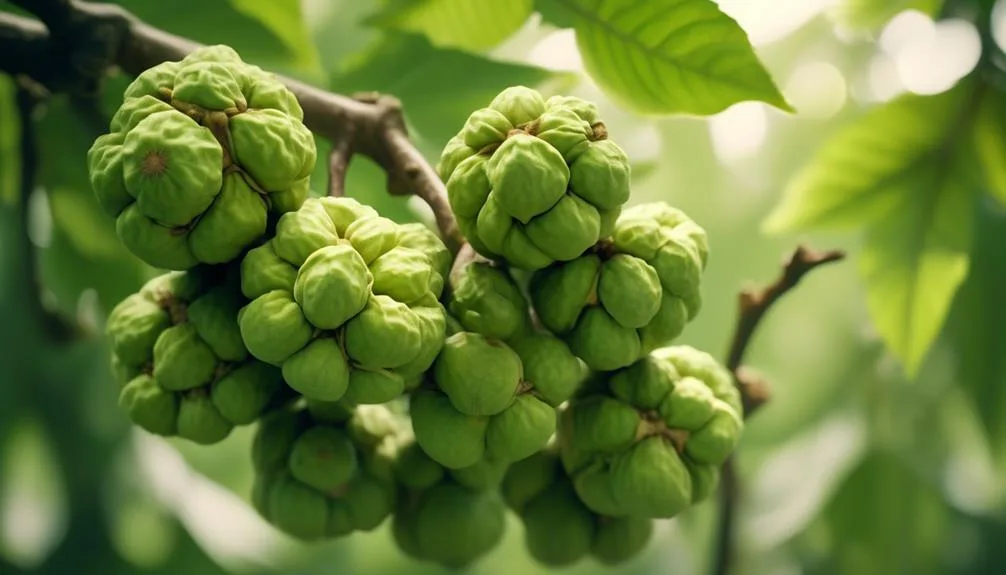Did you know that about 20% of walnuts from walnut trees taste bitter? Ever wondered why? Researchers have been trying to figure this out for years.
Understanding why walnuts turn bitter can tell us a lot about walnut trees, soil, climate, and human practices. So, what causes this bitterness? Let's explore walnut tree genetics, environmental factors, and more to find out.
Key Takeaways
- Genetic mutations can lead to the production of bitter walnuts, so understanding walnut tree genetics is important in creating hybrid varieties with desirable traits and eliminating mutations that cause bitterness.
- Soil and climate factors, such as nutrient deficiencies, pH levels, water availability, and drainage characteristics, can impact walnut tree growth and yield. Optimizing these factors can help reduce the likelihood of producing bitter walnuts.
- The presence of juglone, a chemical compound found in walnut trees, can inhibit the growth of certain plant species and hinder germination and nutrient uptake. Managing juglone presence is crucial in walnut cultivation to prevent the production of bitter walnuts.
- Harvesting and storage practices, such as harvesting at the right time, removing green hulls promptly, thoroughly drying nuts, and storing them in proper conditions, can help preserve the flavor and nutritional value of walnuts and reduce the likelihood of bitterness.
Walnut Tree Genetics
Understanding the genetics of walnut trees is crucial for cultivating desirable traits and ensuring the health and productivity of these valuable plants. Genetic mutations play a significant role in the development of walnut trees. These mutations can lead to changes in the tree's characteristics, affecting factors such as nut size, flavor, and resistance to diseases.
Furthermore, hybrid varieties have been developed to introduce specific traits into walnut trees, such as improved yield, better taste, and disease resistance. By understanding the genetic makeup of walnut trees, researchers and cultivators can work towards creating hybrid varieties that possess the most desirable traits.
This knowledge also allows for the identification and elimination of genetic mutations that may result in bitter-tasting walnuts, ultimately contributing to the cultivation of high-quality walnut trees.
Soil and Climate Factors
When cultivating walnut trees, it is essential to consider the soil and climate factors that directly impact their growth and overall productivity. Nutrient deficiencies and pH levels play a crucial role in the successful cultivation of walnut trees. Additionally, water availability and drainage characteristics significantly influence the health and yield of walnut trees. Here's a table outlining the key soil and climate factors to consider:
| Soil and Climate Factors | Description |
|---|---|
| Nutrient deficiencies | Impact growth and yield |
| pH levels | Affect nutrient availability |
| Water availability | Essential for tree health |
| Drainage characteristics | Prevent waterlogging |
Understanding these factors can help you optimize the growing conditions for walnut trees, ensuring favorable soil quality and climate for maximum productivity.
Presence of Juglone
The presence of juglone in walnut trees can have significant impacts on the growth and health of surrounding plants and trees, making it an important factor to consider in walnut cultivation.
Juglone, a chemical compound found in various parts of the walnut tree, including leaves, roots, and nut hulls, can exert allelopathic effects on neighboring vegetation. Its chemical composition allows it to inhibit the growth of certain plant species and can even be toxic to some.
When considering the effects of juglone, it's essential to understand its potential to hinder the germination and growth of susceptible plants, disrupt nutrient uptake, and cause leaf yellowing and wilting.
Additionally, juglone can persist in the soil for years, affecting the success of future plantings. Therefore, managing juglone presence is crucial in facilitating the growth of compatible plants in walnut-growing areas.
Harvesting and Storage Practices
To ensure the quality of harvested walnuts, proper harvesting and storage practices are essential for preserving the flavor and nutritional value of the nuts. When harvesting walnuts, it is crucial to pick them when the hulls begin to split, allowing for easier removal. After harvesting, it's important to promptly remove the outer green hulls and thoroughly dry the nuts to prevent mold growth. Proper storage is key to maintaining the nutritional value and flavor of walnuts. Store them in a cool, dry place in airtight containers to prevent them from becoming rancid. Here's a handy guide for harvesting and storing walnuts:
| Harvesting | Storage |
|---|---|
| Pick when hulls split | Store in a cool, dry place |
| Remove green hulls promptly | Use airtight containers |
| Dry thoroughly | Avoid exposure to moisture |
Walnuts are rich in nutritional value and have diverse culinary uses, so it's essential to safeguard their quality through proper harvesting and storage practices.
Ways to Reduce Bitterness
To reduce the bitterness of walnuts, soaking them in a saltwater solution can significantly improve their taste and make them more palatable for consumption.
Additionally, there are several other effective ways to reduce bitterness and enhance the overall flavor of walnuts:
- Roasting: Roasting walnuts at a low temperature can help mellow out their bitterness and bring out their natural nutty flavor.
- Blanching: Briefly blanching walnuts in boiling water can remove some of the bitterness, making them more enjoyable to eat.
- Mixing with Sweet Ingredients: Incorporating walnuts into sweet dishes, such as desserts or oatmeal, can help balance out their bitterness with other flavors.
- Grinding: Grinding walnuts into a fine powder and adding them to dishes like smoothies or baked goods can help mask their bitterness while retaining their nutritional benefits.
Conclusion
In the end, the bitterness of walnuts is a result of a complex interplay of genetics, environment, and handling. Understanding these factors can help reduce bitterness and enhance the enjoyment of this nutritious snack.
So, next time you savor a walnut, savor the knowledge that goes into making it a delicious treat.

